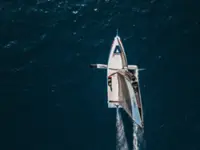A short walk through the dunes of Yorke Bay, and the penguins stand in front of you by the hundreds.
South Atlantic cruises often offer brief stops in the Falkland Islands, and yet there’s so much more to this remote spot than you can see in just a few hours. The adventure begins even as you’re making your way there.
If you don’t want to go far to see the penguins, you can stick with Tony Smith. Totally at ease, the tour guide steers his jeep through the potholes to Yorke Bay.





